Navigation
-
Badge History
- Eagle Scout Medals
- Eagle Scout Badges
- Eagle Scout Pins
- Eagle Scout Square Knots
- Boy Scout Cloth Rank Badges
- First Class Scoutmaster
- Scouting's First Ranger Award
- Did You Know?
- Square Knot Evolution
- Cub Scout Badges
- Cub Scout Uniform
- Den Mother History and Badges
- Silver Outranks Gold
- National and Private Issue Venturing Badges
- Scout Leader Pins
- Die Cut Rank Badges
- Commissioner Badges
-
Other Links
-
References
 First Class Scoutmaster, 1911-1969
First Class Scoutmaster, 1911-1969
There are three classes of scouts among the Boy Scouts of America, the tenderfoot, second-class scout, and First Class Scout." A First Class Scout must be both proficient in scoutcraft and able to "furnish satisfactory evidence that he has put into practice in his daily life the principles of the Scout Oath and Law. Handbook for Boys, 1911
When scouting began and for many years, this non-scoutcraft requirement was only a first-class requirement. Today, it is a requirement of all ranks second-class and higher.
To lead through example and encouragement - that is what is expected of the Scoutmaster. Handbook for Scoutmasters, 1936
By his own example, the Scoutmaster was expected to build character and provide citizenship training. With a daily life based on the principles of the scout oath and law, he could set this example of living the non-scoutcraft requirement of a first-class scout.
By this leadership is meant not only that provided by the Scoutmaster, but also that leadership which is provided by adult Assistants, Junior Leaders and boy leaders, besides the guidance which may be obtained from those men who stand behind the Troop, the members of the Troop Committee. Handbook for Scoutmasters, 1936
For these reasons, these leaders wore emblems of a first-class scout:
- Scoutmaster (1911-1969)
- Assistant Scoutmasters (1911-1969)
- Junior Assistant Scoutmaster (1934-1969)
- Senior Patrol Leader (1934-1971 and 1989-present)
- Troop Committee members (1915-1969).
In 1970, all adult badge emblems were changed to a Tenderfoot design. As understood, this change was to be consistent with the world badge emblem, the World Crest.
Scoutmaster and Assistant Scoutmaster Emblems
Type 1: 1911-1920
The Scoutmaster badge is a green first-class emblem with a brown eagle. The Assistant Scoutmaster badge is a red first-class emblem with a brown eagle.
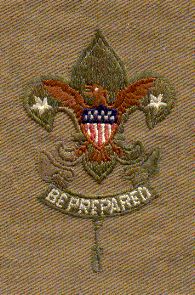
Scoutmaster
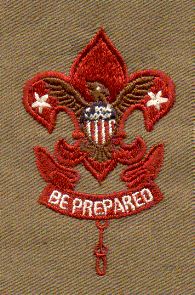
Assistant Scoutmaster
Type 2: 1920-1937
The Scoutmaster badge is a green first-class emblem with a white or silver badge outline and white or silver eagle. The Assistant Scoutmaster badge is a green first-class emblem with a gold badge outline and gold eagle.
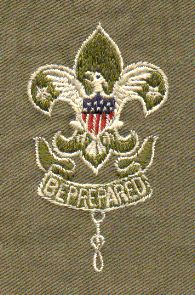
Scoutmaster
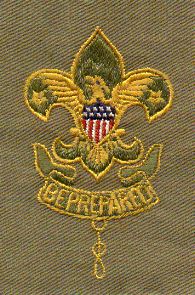
Assistant Scoutmaster
Type 2a: 1934-1935
Both the Scoutmaster and Assistant Scoutmaster of this type are extremely rare.
These are from Paul Myers' collection. Paul found the Scoutmaster badge on a 1935 Jamboree uniform.
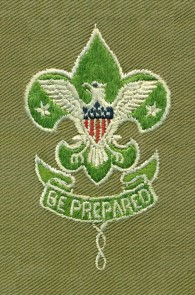
Scoutmaster
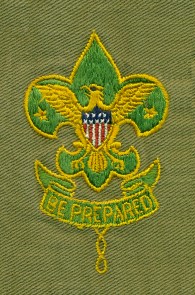
Assistant Scoutmaster
Type 3: 1937-1938
This is the same as the type 2 with a silver line added to the crown for the Scoutmaster and a gold line for the Assistant Scoutmaster.
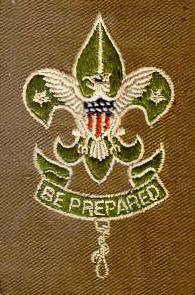
Scoutmaster
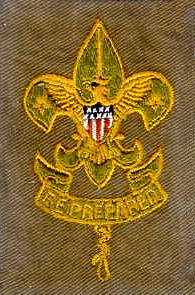
Assistant Scoutmaster
Type 4: 1938-1963
A round cut edge badge. The Scoutmaster's badge has a green background with a white eagle, white border and white lettering "BOY SCOUTS OF AMERICA." The Assistant Scoutmaster's badge is the same except all white was replaced with gold.
From
Dr. Craig Murray:
I have usually seen as the date change from the type 4 to the type 5
listed as 1966, 1967. However, on my youth boy scout uniform is a rolled edge Junior
Assistant Scoutmaster badge. I received this badge at the end of 1963 or possibly the beginning
of 1964. In 1964, I did little if any scouting and my uniform was put away until I began scouting
again in 1987.
For this reason, we have used 1963 as the change year from Type 4 to Type 5
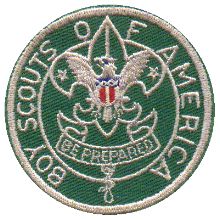
Scoutmaster
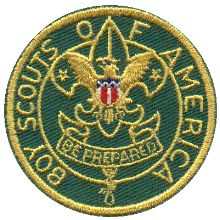
Assistant Scoutmaster
Type 5: 1963-1969
A round rolled edge badge. Except for the rolled edge, the badges are the same as the type 4.
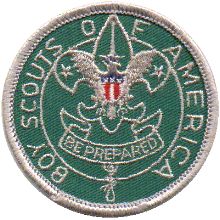
Scoutmaster
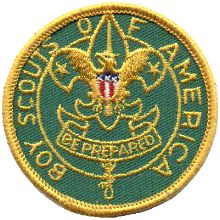
Assistant Scoutmaster
Scoutmaster Collar Pins
For many years, adult leaders wore position pins on their uniform coat collars or lapels. The pins closely matched the cloth badges. Four types worn by Scoutmasters and Assistant Scoutmasters have been identified.
Type 1
The pin was probably first made in 1920 and continued until the mid-1930's. It has a "squatty" crown with the two stars pointing up. The Scoutmaster pin is a green first class emblem with a silver outline and silver eagle. On the Assistant Scoutmaster pin, the silver is replaced with gold.

Scoutmaster
(1920 - mid 1930s)
Type 2
The second pin was probably only made for a year or two in the mid to late-1930's. It was a "wide shoulder" version of the first-class emblem with the two stars at an angle. The coloring of the pins are the same as the type 1.

Scoutmaster
(mid 1930s - 1937)
Type 3
The third pin was a relatively recent discovery. Only the Assistant Scoutmaster pin is known to exist. It appears to be a transition pin because of the similarity of the first class design with the fourth pin. It was likely only made in 1938.

Assistant Scoutmaster
(1938)
Type 4
The last collar pin was made from 1938 until the mid 1960's. It has a tall narrow crown with the stars pointing down. The Scoutmaster pin has a green background with an all silver eagle, silver lettering, and a silver border. The Assistant Scoutmaster pin has gold in place of silver.

Scoutmaster
(1938 - mid 1970's)
First Class Scoutmaster Key: 1913-1925
In 1926, the Scoutmaster's Key was created to recognize the hard work of a Scoutmaster. The requirements were similar to today's requirements with the exception of the time requirement which was five years. The Scoutmaster's Key was a gold first class emblem superimposed on a symbolic key, suspended on a green, white and green ribbon.
The first-class emblem was used through 1946. In 1947, the emblem was changed to tenderfoot. It is likely that at that time, the tenure was changed from five years to three years.
Ribbon bars were introduced in 1934 to represent awards earned. The Scoutmaster's Key ribbon bar matched the ribbon used for the metal, green, white, and green. The ribbon bar was discontinued in 1946 with the creation of square knots.
Today, this key is called the Scouter's Key. It is most commonly represented by the green and white square knot with a tan background.
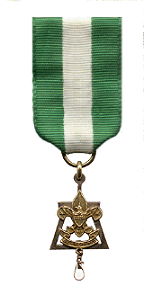
Scoutmaster's Key
(1928-1946)
Credits:
- Position badges pins scanned from the collection of Ron Vinatieri's and Paul Myers' collections.